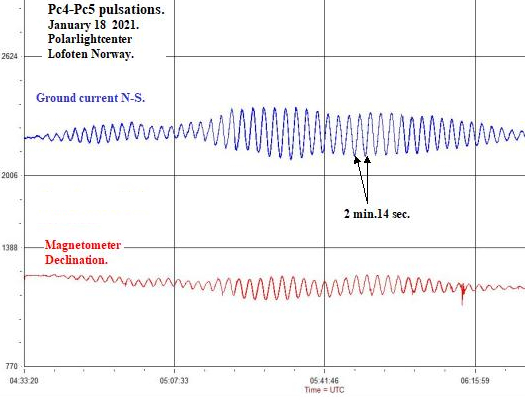And rather surprisingly it was the opening chord from the Beatles' "A Hard Days Night".
Test your musical knowledge: What was that chord?
- A dominant 9th of F in the key of C
- G-C-F-Bb-D-G
- C-Bb-D-F-G-C in the key of C
- A polytriad ii7/V in Ab major
- G7sus4 (open position)
- D7sus4 (open position)
- G7 with added 9th and suspended 4th
- A superimposition of Dm, F, and G
- Gsus4/D
- G11sus4
- G7sus7/A
- Dm11 with no 9th
- Gm7add11
- G9sus4/D
Answer below. And now from SpaceWeather:
...A MUSICAL NOTE FROM THE MAGNETOSPHERE: High above the Arctic Circle in Lofoten, Norway, citizen scientist Rob Stammes operates a space weather monitoring station. His sensors detect ground currents, auroras, radio bursts, and disturbances in Earth's magnetic field. Yesterday, he says, "I received a musical note from the magnetosphere."
"Around 05.30 UTC on Jan. 18th, our local magnetic field began to swing back and forth in a rhythmic pattern," he says. "Electrical currents in the ground did the same thing. It was a nearly pure sine wave--like a low frequency musical note. The episode lastesd for more than 2 hours."
Stammes has received such notes before, but they are rare. "I see a pattern like this only about once a year," he says.
Space physicists call this phenomenon a "pulsation continuous" or "Pc" for short. Imagine blowing across a piece of paper, making it flutter with your breath. Solar wind does the same thing to magnetic fields. Pc waves are essentially flutters propagating down the flanks of Earth's magnetosphere excited by the breath of the sun....
....MORE
If you guessed the opening chord of A Hard Day's Night is an F add9 you are correct!!
And I lied, that was not what was heard in the skies above Norway.
However, you can see The Beatles Bible for even more on this unique opening.
Or just listen to the song.
